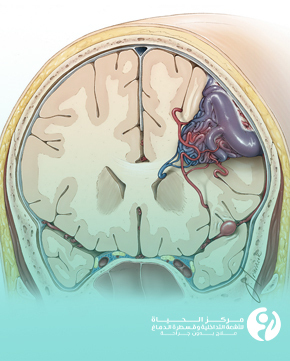
A cerebral arteriovenous malformation is a vascular malformation that can cause serious symptoms. Treatment of a cerebral arteriovenous malformation with cerebral catheter angiography aims to reduce the size of the malformation or stop the flow of blood through it.
What is a cerebral arteriovenous malformation?
Cerebral arteriovenous malformation (AVM) is a rare condition caused by an abnormal formation of blood vessels in the brain, where arteries and veins are directly intertwined without a capillary network between them. Normally, blood flows from arteries to tiny capillaries and then to veins. But in the case of a cerebral Arteriovenous malformation, there is a direct and abnormal connection between the arteries and veins, which leads to rapid and irregular blood flow and can cause pressure on the surrounding brain tissue, increasing the risk of a cerebral hemorrhage.
What are the symptoms of an arteriovenous malformation?
A cerebral arteriovenous malformation may not cause any symptoms at first, but when they appear, symptoms can vary depending on the size and location of the malformation and include:
- Severe headaches: This is usually the first and most common symptom and can be chronic or come in the form of severe attacks.
- Seizures: A cerebral arteriovenous malformation can cause seizures.
- Weakness or paralysis: The patient may develop weakness or paralysis in part of the body.
- Vision loss or double vision: These symptoms may occur if the areas of the brain responsible for vision are affected.
- Difficulties with speech or comprehension: Language abilities may be affected if the areas of the brain responsible for vision and speech are affected.
- Dizziness and loss of balance: A cerebral arteriovenous malformation can affect movement and balance.
- Intracerebral hemorrhage: A burst cerebral arteriovenous malformation can lead to severe hemorrhage in the brain, which is the most serious complication and occurs when the blood vessels rupture, causing severe neurological damage and even death.
Cerebral arteriovenous malformation Diagnosis and treatment:
How is a cerebral arteriovenous malformation diagnosed?
Diagnosing a cerebral arteriovenous malformation requires the use of advanced imaging techniques to determine the location and size of the malformation and among the most prominent means of diagnosis:
- Magnetic resonance imaging (MRI): Provides detailed images of the brain structure.
- Computerized tomography (CT scan): Helps determine the location and size of the cerebral arteriovenous malformation and can detect brain hemorrhage.
- Computed tomography angiography (CTA): Provides fine details of the blood vessels in the brain.
- Digital Subtraction Angiography (DSA): This is the most accurate means of identifying and treating vascular abnormalities.
How is a cerebral arteriovenous malformation treated?
The treatment of a cerebral arteriovenous malformation depends on several factors, including the size of the malformation, its location, the patient's age, general health, and symptoms. The treatment options include:
- Monitoring: If the AVM is small and does not cause any symptoms, your doctor may recommend regular monitoring.
- Medications: To control symptoms such as seizures and headaches.
- Stereotactic Radiosurgery: High-energy beams can target and shrink the deformity.
- Traditional surgery: to surgically remove the deformity, which is used in certain cases.
- Endovascular procedures (Embolization): A cerebral catheter angiography is used to close off tangled blood vessels in a cerebral arteriovenous malformation by injecting special materials through the catheter.
Catheter-based treatment of cerebral arteriovenous malformations (Endovascular Embolization):
Cerebral catheter angiography is a medical procedure in which a thin, flexible tube (catheter) is inserted through an artery in the groin and into the brain. The catheter is guided using imaging techniques such as X-rays or magnetic resonance imaging (MRI) to reach the location of the arteriovenous malformation.
Cerebral arteriovenous malformations can be treated with catheterization in several ways, including:
- Vessel occlusion: Special materials are injected through the catheter to block the blood vessels, feeding the malformation, reducing blood flow, and causing it to shrink or disappear.
- Blood Flow Diversion: Blood can be directed away from the arteriovenous malformations by creating new pathways for blood flow.
- Use of particles: Very small particles can be injected into the arteriovenous malformations to block small blood vessels.
Advantages of catheter-based treatment of cerebral arteriovenous malformation:
- Less invasive: Compared to surgery, cerebral catheter angiography is a less invasive procedure, which means a shorter recovery time and less scarring.
- High precision: The catheter can be guided with high accuracy to reach the cerebral arteriovenous malformation.
- Flexibility: Catheters can treat abnormalities of different sizes and locations.
The best doctor in arteriovenous malformation treatment:
The search for the best doctor for arteriovenous malformation treatment requires consideration of the doctor's experience and specialization in neurovascular treatments. Al Hayat Center for Interventional Radiology and Neurointervention in Iraq has a team of experienced and qualified doctors who use the latest international methods in the fields of interventional radiology and brain catheter angiography to achieve the highest level of quality and accuracy in results and meet patient satisfaction.
In conclusion:
Cerebral arteriovenous malformation is a serious condition that requires careful diagnosis and specialized treatment. Cerebral catheter angiography is one of the most effective treatments for minimizing the risks and improving the patient's health. Seeking the best doctors in the specialized medical center can increase the chances of successful treatment and full recovery.

